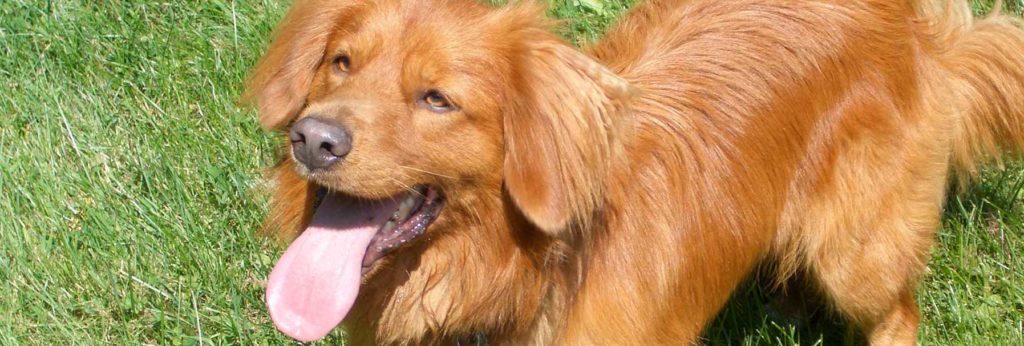Who’s the Smartest of Them All?

Digby. Not a border collie, but a Duck Tolling Retriever.
Some Reflections on Dogs, Humans, and Being Smart.
First there was Rico. In 2004, researchers reported that a border collie had learned the names of over 200 objects. What’s more, Rico could recognize a new word and retrieve a new object from among a group of familiar objects, inferring the name of the new object through the process of elimination, seven out of ten times, and retain the knowledge for a month. Pretty smart!
Then came Chaser in 2011. When John Pilley, a retired professor of psychology, heard about Rico, he wondered: Could the number of words be higher if the researcher really knew how to train a dog? He adopted a puppy and set to work. A high-octane border collie, Chaser learned the names of 1,022 objects, and appeared not only to grasp the words for categories of objects but also to distinguish between a noun and a verb. She might have kept on expanding her vocabulary, but, like many a border collie before her, she wore out her human, and he stopped teaching her new words. Chaser became known as the smartest dog in the world.
In 2019, Whisky, another border collie, proved remarkable in a different way. While Rico and Chaser were deliberately trained, Whisky learned the names of the toys in the course of playing much the way children learn—through social interaction—and kept playing, and playing, and playing.
Whisky became part of the Genius Dog Challenge, a study conducted remotely in 2020 by Claudia Fugazza, a dog trainer and researcher in the Department of Ethology at Eötvös Loránd University in Budapest (home base for some of the world’s best research on dogs). Six super-smart dogs from around the world, most but not all border collies, were given the same challenge: Learn six new names for six new toys in a week. Then, the six toys were laid out, mixed in with a few of the dog’s other toys. The dogs were asked to fetch objects by name. Four of the dogs got all six names right, while the other two got five. In phase two, the dogs learned the names of 12 new toys. Two aced the test and got all 12 right, while the others got 11. Like Rico and Chaser, these dogs also had good recall after the toys were put away, a month and even two months later.
These feats prompt big questions: Do these genius dogs use words the way we use them? Can a word be a symbolic representation to a dog? Researchers tentatively say yes. Pilley believed that Chaser “acquired referential understanding of nouns, an ability normally attributed to children.”
I’m thrilled by the stories of these dogs. I’m always thrilled when I hear that an animal is smarter than we thought. When my assumptions get upended. When our collective claims to human exceptionalism turn out to be wrong. And most important, when it becomes clear that animals have a richer understanding of the world than we give them credit for.
But why are we obsessed with the “smartest” dog? And why focus on language? We seem to think that the more like humans dogs are, the smarter they must be. I’m much more curious about how smart dogs are on their own terms and what those terms might be, and not just the Ricos, Chasers, and Whiskys of the dog world, but your run-of-the-mill dog.

The key to canine “smarts” appears to be their flexible social intelligence. Evolutionary anthropologist and dog researcher Brian Hare has studied thousands of average dogs—beloved household pets, shelter dogs, puppies, and even tame wolves, used as controls—and has carefully demonstrated that dogs can read the communicative intentions of humans (and wolves cannot). Importantly, other researchers have independently replicated his results many times over. This ability seems so obvious that we barely notice it. It isn’t just that they come when we call or sit as a result of operant conditioning. They perceive our signals and make inferences about what we mean. (I wrote about some of the ways they read us more specifically in an earlier article, “Canine ESP.”) Of course, all social species read the signals of others of their own kind. That’s what social means. But dogs understand the signals of another species, as well. In this mental ability dogs resemble humans—or should I say humans resemble dogs? Hare describes this as evolutionary convergence, when two species evolve along separate tracks but converge on the same adaptation. Usually, the adaptation is a physical trait, but dogs and humans independently evolved a similar cognitive ability. In this regard, dogs resemble us even more than chimpanzees do, though chimps and humans are much more alike genetically.
Since I’ve been working on this article, I’ve paid closer attention to my everyday communication with my dog Zola. On a recent morning walk, she and I reached a fork in the path. She was well ahead of me and started to trot to the left. I wanted to take the right fork and said a soft, upbeat “Hey,” which is not a word we use as a command, such as “Here.” Without even glancing back, she cut right. This is a simple moment, on a path we often take, but she read my signal and intention almost instantaneously. Of course, human-canine communication isn’t always so simple. It helps (a lot) if your intention and the dog’s intention line up, at least to some extent. If there’d been a squirrel in sight—in whatever direction—she would have sped off in hot pursuit and caught up with me later.
Humans have lived with dogs for so long that we take these interactions and our dogs’ social intelligence for granted. I’m not sure it even registers with most of us as intelligence. It should, though, because in evolutionary terms their social smarts have enabled their species to be spectacularly successful. As ethologist and founding director of the Dog Cognition Lab at Barnard College Alexandra Horowitz describes dogs, they are “social opportunists…attuned to the actions of others, and humans turned out to be very good animals to attune to.”
This brings me, a bit sheepishly, back to language. Maybe human language does matter to your average canine social opportunist. Though many scientists argue that dogs key in to the emotion rather than the meaning of our words, the recent work with Rico, Chaser, and other dogs suggests that dogs can understand words symbolically. Using linguistic tests designed for little kids, researchers found that your average dog can learn about 165 words and gestures and has the mental abilities akin to those of a two- or two-and-a-half-year-old human. Genius dogs such as Rico and Chaser are more like three-year-olds. Psychologist Stanley Coren, who led these studies, claims that “Evidence from testing dogs suggests that language is not an ability possessed only by humans.”
Those used to be fighting words, and still are in some quarters, but close observation of social species in the wild complements this claim. The Gunnison’s prairie dog, for example, has a rich descriptive language, with specific vocabulary used to identify a predator’s type, size, and behavior. They have calls for colors and for certain shapes. They may even produce new “words” using the constituent parts of other calls. It’s Prairiedogese! This discovery was impossible with the naked ear. Only with computers to slow and break down the parts of their chee-chee-chee calls could researchers detect fine distinctions and connect them with things in the environment. Then there are sperm whales. Calling across large underwater distances, the whales rely entirely on acoustic communication in patterns of clicks called codas. What meanings are relayed in these codas? In 2020, an international interdisciplinary group of scientists—including marine biologists, computer scientists, robotics engineers, and linguists, among others—launched Project CETI (Cetacean Translation Initiative) to use robots and machine learning to parse their clicks.
I’m calling this article “Who’s the Smartest of Them All?” not so much to refer to Rico, Chaser, and Whisky, but more to invoke the wicked queen of the fairytale. We humans are an awful lot like her and always want the answer to be: “We are.” Of course we are in a host of ways, but, like the queen who obsessively asks her magic mirror for reassurance, we seem painfully insecure. One of our main claims to exceptionalism has been our monopoly on language. The evidence suggests, however, that human intelligence is simply another variety of animal intelligence.
Until recently, almost all philosophers and theologians in the mainstream Western tradition have defined human in opposition to animal. Two big questions arise again and again: What are humans in relation to animals? What is the right treatment of animals, and especially animals on whom humans depend? Plato entertained the possibility that animals had reason, and therefore souls, but Aristotle rejected that idea and constructed an elaborate ladder of life on which all living beings were hierarchically ranked. He granted neither reason nor souls to animals, and judged humans to be not just better than animals but altogether different, as if we can only be human by virtue of not being animal. For millennia, we’ve drawn a bold line between us and them—with reason, goodness, and the soul on one side; and instinct, brutishness, and physicality on the other.
In the Judeo-Christian creation story, God created man in his image (and woman in man’s image, more hierarchical thinking). The rest of nature, created separately, exists expressly for the benefit of humans. In the 4thcentury CE, Augustine integrated the Greek ladder of life into Christian theology and so conferred divine meaning and authority on a secular philosophy. Even in the face of the robust evidence of evolution, this paradigm has had remarkable staying power, influencing the way we in the West have thought about animals ever since. It has made it easier, morally, to mistreat and destroy animals and their habitats.
I use we in the West carefully, since this has not been true in all cultures or times. Even in the West, many people have seen, and see, all of nature within large webs rather than in an instrumental hierarchy. The thinking and patient research that inform this article clearly wouldn’t exist otherwise. Ecology, the study of the relations of organisms to one another and to their physical environment, describes our complex interdependence. The word ecology itself, coined in the late 19thcentury, and originally spelled oecology, comes from the Greek root oikos, which means house or household. We all live in this house together.
 How can we enlarge our understanding of intelligence? In Other Minds (2016), Peter Godfrey-Smith, a philosopher, science historian, and scuba diver who studies octopuses and cuttlefish, describes our limited perception of other animals’ minds: “we often wind up visualizing scaled-down versions of ourselves.” In a word, we anthropomorphize. When we think a dog is as smart as a human toddler, the analogy clicks. Since for us language is thinking, we test animals for their abilities to understand language and rate their intelligence accordingly. Similarly, we are used to seeing ourselves in mirrors, so we use a mirror test to determine if an animal has the ability to associate itself with the animal in the mirror. Does this species have a sense of self or self-consciousness like we do? Great apes and dolphins figure out that they are seeing themselves in the mirror, and even study themselves. We identify with their self-scrutiny. Dogs flunk the mirror test, but what have they failed to do?
How can we enlarge our understanding of intelligence? In Other Minds (2016), Peter Godfrey-Smith, a philosopher, science historian, and scuba diver who studies octopuses and cuttlefish, describes our limited perception of other animals’ minds: “we often wind up visualizing scaled-down versions of ourselves.” In a word, we anthropomorphize. When we think a dog is as smart as a human toddler, the analogy clicks. Since for us language is thinking, we test animals for their abilities to understand language and rate their intelligence accordingly. Similarly, we are used to seeing ourselves in mirrors, so we use a mirror test to determine if an animal has the ability to associate itself with the animal in the mirror. Does this species have a sense of self or self-consciousness like we do? Great apes and dolphins figure out that they are seeing themselves in the mirror, and even study themselves. We identify with their self-scrutiny. Dogs flunk the mirror test, but what have they failed to do?
It may be impossible to escape our own heads when we think about thinking. Anthropomorphism at least sympathetically likens animals to humans and provides an entry point to other minds. But it creates problems, too. As we project ourselves into an animal’s experience, we may see kinds of intelligence that aren’t there and fail to see ones that are, and so miss remarkable kinds of intelligence altogether. Which “mirror tests” are we flunking?
Another answer to the question of how smart dogs are in dog terms is surely their superlative sense of smell. Dogs gather immense amounts of information about the world through their noses, but we humans don’t give much credit to smell as intelligence. It’s “just” a sensory ability, one we’ve even bred dogs for because it’s so useful, but intelligence? Our Aristotelian bias kicks in: Other animal minds are always less-than-human rather than different-than-human. Besides, we’ve treated our own sense of smell as lower, even animalistic, and practically irrelevant for centuries.
I’d like to think more expansively about smell as a distinctive form of intelligence. When I walk Zola in the woods, she and I clearly have radically different experiences. I pick up the smell of the forest and even details within the smell-scape, but with little sophistication. My olfactory experience is largely judgmental and emotional. One thing smells delicious and something else repulsive, another triggers a memory, and each scent grows less perceptible as I grow habituated to it. Zola, by contrast, takes in specific information with great acuity and does not grow habituated to a scent. She doesn’t have my emotional reactions, whether she’s sniffing shit or daffodils. In fact, she’s probably more interested in the shit because it may contain nutrients and relevant social information. What’s more, she can smell the difference between the present, the recent past, and the past. She can tell which direction a dog or squirrel was moving based on the relative freshness, or erosion, of its scent. This means that, as she sniffs her way through the woods, she lives not only in the present but also in layers of time, because, for her, any given space emanates its own recent history. The closest analogy I can come up with, one that makes sense to my human brain, is visual: a photograph of a space that projects new images, while preserving the old ones in progressively fainter shades. But I have no idea if this analogy does justice to Zola’s olfactory experience.
I’ve downplayed human abilities here. Actually, we make millions of fine distinctions among scents: vanilla, wood smoke, ginger, freshly cut grass, ammonia, peanut butter, fresh bread, chile pepper, gasoline, olive oil, and the list goes on and on. You may have just experienced a montage of scents! We use scent as a source of information all the time. Sommeliers, coffee tasters, and parfumiers develop encyclopedic knowledge of scents, and their acute well-trained sense of smell is a bankable form of intelligence. Like dogs, humans can also smell recent history, such as traces of a cologne a person leaves behind or the onions and garlic that flavored last night’s dinner. Smell may be a bit like proprioception, our sense of where the body is and how it moves in space. Without trying or paying much attention, we continuously use both senses to orient ourselves to our surroundings. Neuroscientists believe that smell helps us build mental models of our environment, so we can monitor our surroundings and respond. Mostly, we take smell for granted, but, as many people with COVID lost their sense of smell, they felt the loss keenly.
But I haven’t exaggerated canine abilities. Dog noses outdo even the most highly trained human noses by an order of thousands. The dog’s olfactory system includes the surface of its moist nose; the structure of its nostrils, including the side slits, that enable a dog to exhale and continue to draw in new scent at the same time; its muzzle, full of folds and folds of nasal tissue; its long floppy tongue; and its saliva. In hounds, even their long ears play a part by stirring up scent from the ground. Finally, a dog doesn’t just have millions more receptor cells than we have, but more kinds of receptor cells, so dogs don’t simply smell what we can smell better and at much lower thresholds, but smell things we never smell at all. We marvel at a dog’s ability to sniff out cancer. Isn’t that intelligence?
 How do we measure how “smart” an animal is, much less compare it with another? Godfrey-Smith describes the problem this way: “When we try to compare one animal’s brainpower with another’s, we also run into the fact that there is no single scale on which intelligence can be sensibly measured. Different animals are good at different things, as makes sense given the different lives they live.” He compares the brain with a tool kit. All animals have a basic collection of mental tools—sensory perception; the capacity to do things; the ability to match their actions to the environment; the ability to learn, remember, and apply the past to the present; the ability to solve problems—but after that there’s an awful lot of variety. He sums it up: “Different tool kits go with different ways of making a living.” Brian Hare also uses a tool metaphor, with a fun twist: “Asking if a dolphin is smarter than a crow is like asking if a hammer is better than a saw.” In other words, what’s an animal’s particular intelligence for?
How do we measure how “smart” an animal is, much less compare it with another? Godfrey-Smith describes the problem this way: “When we try to compare one animal’s brainpower with another’s, we also run into the fact that there is no single scale on which intelligence can be sensibly measured. Different animals are good at different things, as makes sense given the different lives they live.” He compares the brain with a tool kit. All animals have a basic collection of mental tools—sensory perception; the capacity to do things; the ability to match their actions to the environment; the ability to learn, remember, and apply the past to the present; the ability to solve problems—but after that there’s an awful lot of variety. He sums it up: “Different tool kits go with different ways of making a living.” Brian Hare also uses a tool metaphor, with a fun twist: “Asking if a dolphin is smarter than a crow is like asking if a hammer is better than a saw.” In other words, what’s an animal’s particular intelligence for?
Many people insist that dogs are wolves dumbed down by domestication. Indeed, on a number of physical problem-solving challenges wolves clearly outperform dogs. In one well-known test, food is placed in a closed box that is challenging to open. The wolves keep at it until they get the lid off, while the dogs give up working on the box pretty quickly. This doesn’t mean, however, that the dogs give up on solving the problem. Instead, they recruit help from nearby people. In this kind of test, Horowitz observes that dogs are hampered by their particular brand of smarts. They’ve learned to “cleverly look to us” to open the box (and save themselves some trouble in the bargain). Yes, you can argue that domestication makes dogs dumber than wolves, or look at it from another perspective: Dogs’ social intelligence enables them to use humans as tools to get what they want. Pretty smart!!

Zola with "Reverence," a sculpture by Jim Sardonis, in the background.
References (in the order of their first appearance):
Nicholas Wade. “Sit. Stay. Parse. Good Girl!” The New York Times, January 17, 2011.
Brian Hare and Vanessa Woods. The Genius of Dogs: How Dogs Are Smarter Than You Think.
Plume, 2013.
Alexandra Horowtiz. Inside of a Dog: What Dogs See, Smell, and Know. Scribner, 2009.
Stanley Coren. “In the Minds of Dogs: Think Cat in the Hat for Talking to Dogs.” Psychology
Today, September/October 2017.
Peter Godfrey-Smith. Other Minds: The Octopus, the Sea, and the Deep Origins of
Consciousness. Farrar, Straus and Giroux, 2016.
